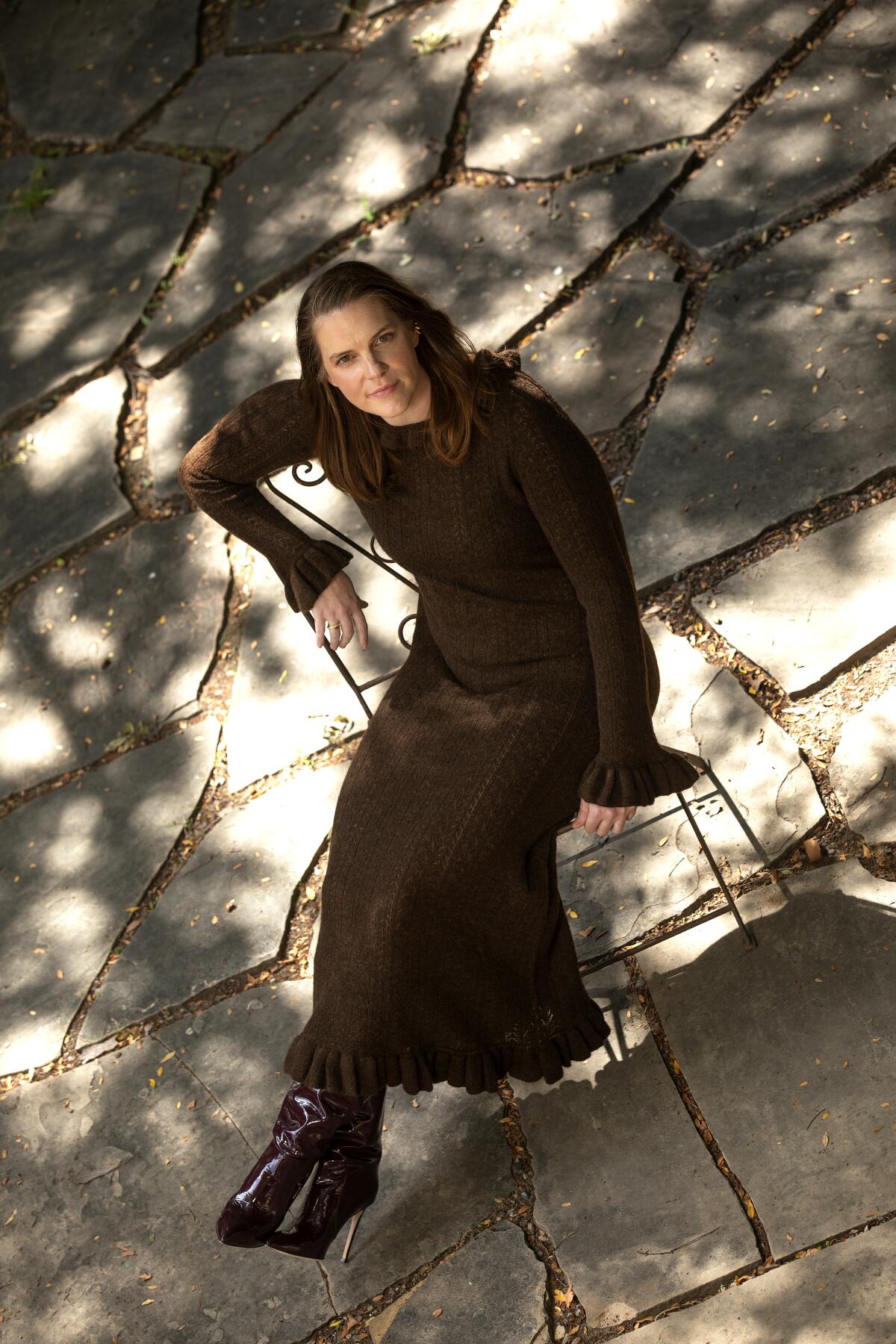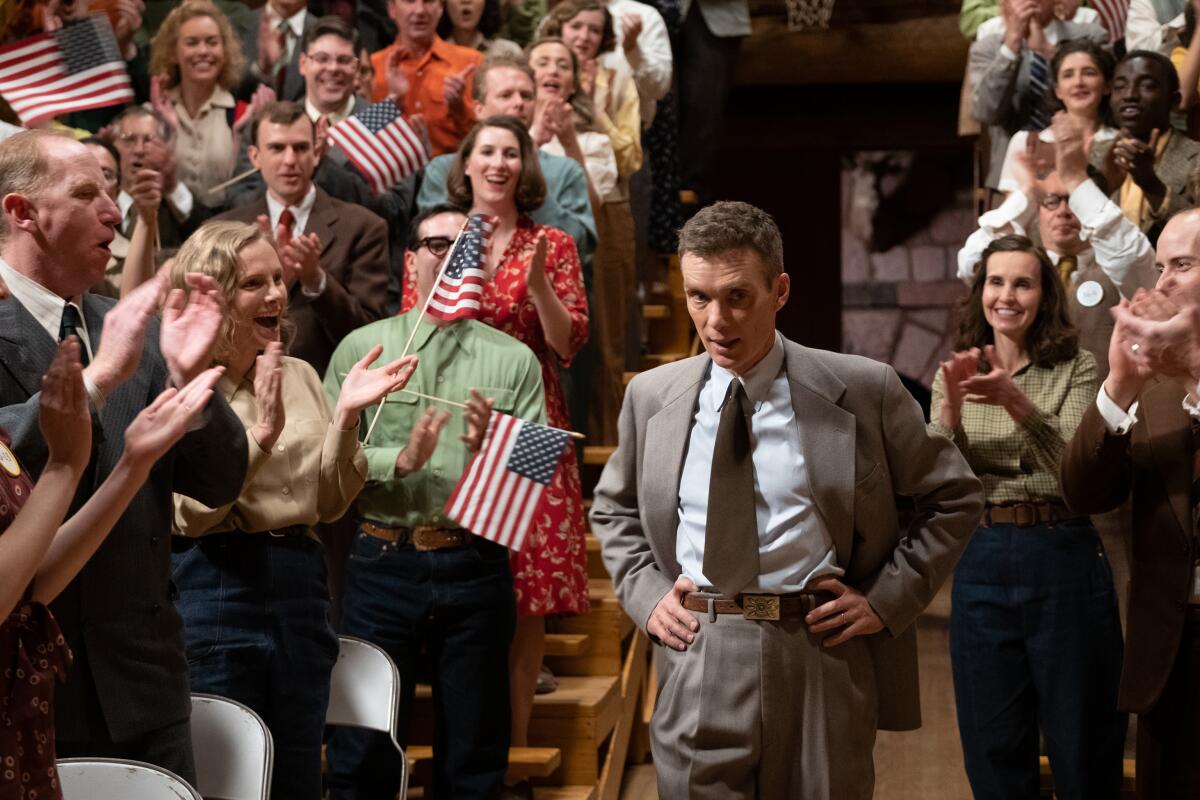‘Oppenheimer’ editor Jennifer Lame knows the pressure of making quick cuts on film

- Share via
For editor Jennifer Lame, there’s nothing more exciting than “people talking in rooms.” As a key collaborator of director Christopher Nolan on the blockbuster biopic “Oppenheimer,” Lame’s sharp eye and keen sense of pacing helped mold a dialogue-driven epic into the year’s most intelligent thriller.
Over the last decade, Lame has provided the connective tissue for some of Hollywood’s most emotionally shattering dramas — including Kenneth Lonergan’s “Manchester by the Sea” and Noah Baumbach’s “Marriage Story” — but the complexity and scope of the “Oppenheimer” workflow makes it her most ambitious accomplishment yet. Lame spoke with The Envelope by phone from her home in Los Angeles.
You described yourself as a “movie nerd kid.” How did you become an editor?
After studying film at Wesleyan, I went out to L.A. but found it very difficult to break into the film world. I ended up working at a start-up, editing commercials from stock footage.
A friend from Wesleyan had a sister who was an assistant editor for Woody Allen and Sidney Lumet. And I said if she ever needs anyone, I would literally drop everything and move back to New York. She called me one day and said her apprentice editor bailed on her on a Friday and she needs someone on Monday.
And she said, “If you can get here, I’ll get you into the union. I’ll teach you whatever you want to know.” So I quit my job. I left my apartment and gave it to a friend. And I moved back to New York. And she got me into the union. And then I worked my way up.
How did you start working with Christopher Nolan on “Tenet”?
I was finishing “Marriage Story,” and I got a call from my agent that Chris Nolan was looking for an editor. My agents had put me on some list, because they knew that he was someone I found interesting.
I didn’t really think I had a shot at the job. I’m not being self-deprecating, but if you look at my résumé, it makes absolutely no sense. I thought my agents were just being nice, and open to weird ideas, and I would love to just meet this person and ask him a couple questions.
So I flew out to meet him, and I was really nervous. We ended up just talking, and he was really open about his process, and it was very interesting. And then the interview ended pretty quickly, and I went right back to the airport and got on the plane and thought nothing of it. When I got the job, I was shocked. Like, I remember where I was when I found out. I was thinking: “This is crazy.”

“Oppenheimer” must have had an incredibly complex workflow, since you had digital and film and 65 millimeter Imax. How did it all work?
I’m in my own room with Chris, and then there’s a whole editorial team, and we edit on Avid. Then following behind us is another crew, a film crew, who were in Toluca Lake, in what we called “the film house.” So they have all the film, and they’re following along behind us as I’m cutting the film, because Chris screens his director’s cut for the studio as a film work print.
So as we’re cutting, they’re following behind cutting too, which is very intimidating. Usually, when you’re cutting digitally, you can do a lot of fancy tricks on the computer. But when you have a film team literally making slices, you can’t do those things. And if I cut off two frames by accident while making a quick cut in the computer, then someone on the film crew is going to physically [replicate] that. It’s actually really lovely to have that heightened awareness.
Nolan is a meticulous screenwriter, and the “Oppenheimer” script was already pared down from a 700-page source text. Did that present any special challenges for an editor?
When I first read that script, I tore through it. It was pared down to the essentials, but it’s so rich. It’s intimidating when you work on a movie whose script is so perfectly planned out, and then you have to edit that. I wanted the audience to experience what I felt when I first read that script when they watched the movie. And that’s really hard to do.
Pacing was instrumental, because there was a potential for this movie to feel too rushed, and if the beginning was too rushed, then you wouldn’t lock in with Oppenheimer the character. So we were constantly calibrating all of that, and we screened it once a week for two or three people in order to figure out where those little tweaks needed to happen.
How come you don’t do a lot of interviews?
I find it difficult to be very articulate about the editing process. A lot of questions I get asked are like, “Tell me a scene where you had a huge influence on changing what was shot.”
People are looking for ”What did the filmmaker f— up that you fixed?” And that’s not my job at all. My job is to collaborate with the filmmaker — which I know is not interesting to talk about — and to create an environment where the filmmaker feels like they can make the best version of their movie.
More to Read
From the Oscars to the Emmys.
Get the Envelope newsletter for exclusive awards season coverage, behind-the-scenes stories from the Envelope podcast and columnist Glenn Whipp’s must-read analysis.
You may occasionally receive promotional content from the Los Angeles Times.










